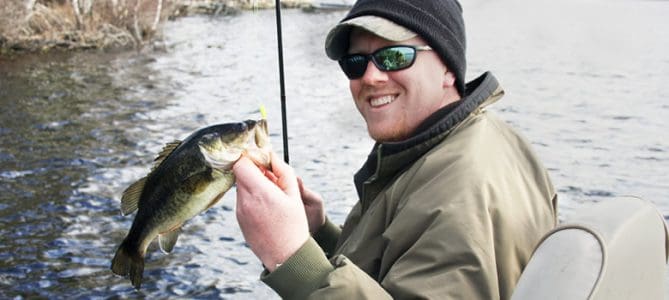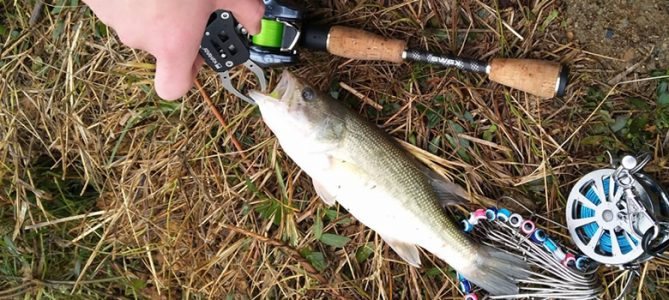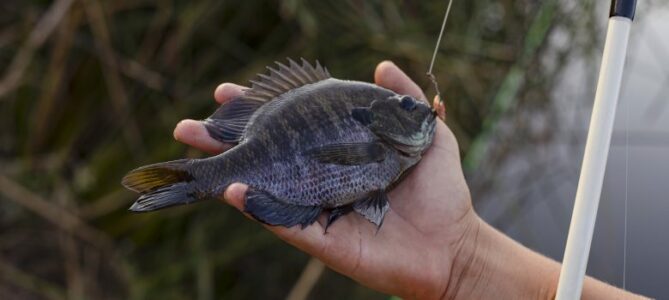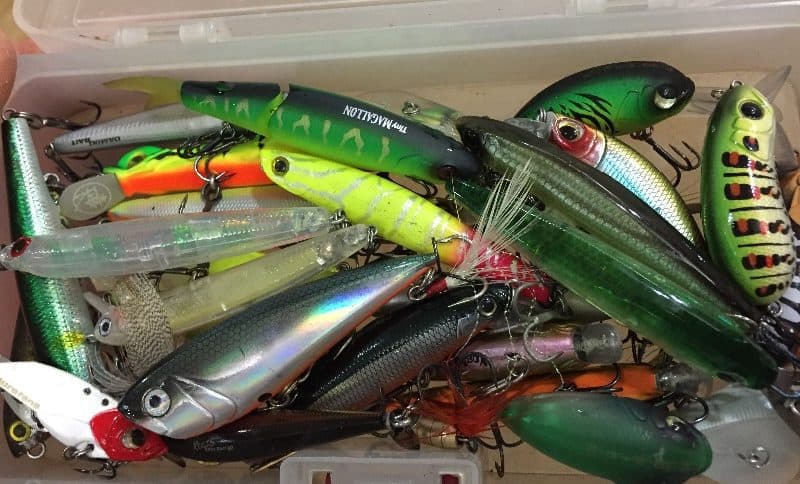If you buy via a link on this page, we may receive a commission, at no extra cost to you.Learn more
The soft plastic world of bass fishing can be overwhelming, and a fluke is one lure within that world that can draw a lot of questions from anglers. If you are wondering what a fluke is, how to fish a fluke when to fish a fluke, and the effectiveness of a fluke, you are not alone.
Fluke is a popular and effective lure for catching bass on conventional gear. The term “fluke” is often used interchangeably with “soft plastic” and “jerk bait” and is valued for its imitation of a dying baitfish. Bass love them!
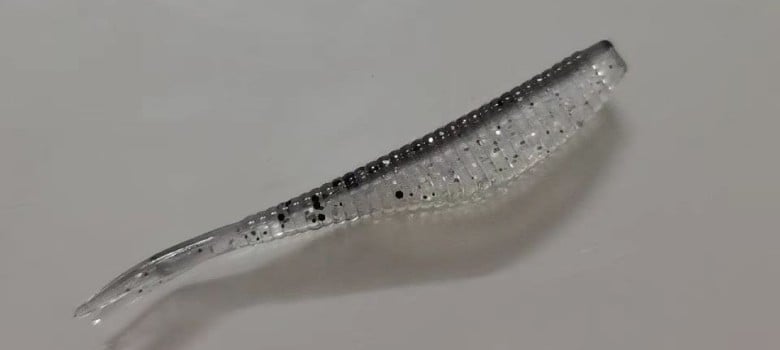
However, despite a fluke’s appealing profile and tempting action, tying one on doesn’t mean an automatic catch. Flukes come in a variety of lengths and colors. Choosing the correct fluke, pinpointing when to fish a fluke, and knowing how to fish a fluke will be the difference maker in catching more fish.
Understanding Fluke Lures
Fluke lures are a type of soft plastic lure that you will find at any outdoor or fishing shop. You can identify flukes by their long, slender bodies that taper to a split tail. You can also find fluke sold with a paddle tail, but the paddled tail will make your lure swim straight rather than the erratic motion that so many anglers love.
Best Fluke Sizes
Flukes come in various sizes, but the sweet spot for bass fishing is 5, 6, or 7 inches long. Like any other type of fishing, having some variation in the size of your lure will be vital for adapting to the bass’s behavior. If the bass is apprehensive, going to a 5-inch fluke may help. On the contrary, fishing a 7-inch fluke may yield a personal record bass if the fish are very aggressive. Either way, versatility in your tackle will be critical for success.
Should you put a weight on a fluke?
Fluke lures come in a weighted or unweighted style. Anglers prefer to have each, though unweighted flukes are more popular. Each holds its advantages regarding sink rate and swim pattern. With a weighted fluke, your lure will reach the bottom faster, but you sacrifice the erratic movement that bass sometimes love. With an unweighted fluke, the lure slowly drops through the water column but has an irregular swim pattern to catch the attention of nearby fish.
What color fluke is best for bass?
Flukes that come in natural colors are very popular for a good reason: they work. My favorite fluke colors include watermelon red flake, green pumpkin, white pearl, electric shad, and gray. Again, don’t overthink this decision: flukes are appealing because they naturally imitate a dying baitfish. Therefore, natural color is an obvious choice.
Read More: Are Rooster Tails Good For Bass?
How to Fish A Fluke
Now that you know which flukes are the best for bass fishing, let’s dive into how to fish these effective lures.
Rigging A Fluke
- Rods & Reels: You can fish a fluke with either spinning or baitcasting gear. If you use baitcasting gear, I suggest using weighted hooks or weighted flukes because a baitcasting rig requires more heft to cast your desired distance. On the other hand, a spinning tackle will be perfect for an unweighted fluke. Seven-foot medium action spinning and baitcasting rods are standard for fishing flukes.
- Hooks: 3/0 to 5/0 offset and standard worm hooks are most common for bass fishing with a fluke. You can rig these in various ways, including double rig, underspin, scrounger, and Neko rigs. However, a Texas rig is most common. All you have to do is stick the nose of your fluke through the hook point and run that hook through the belly until it is barely sticking out.
- Line: generally, your line weight will be best in the 8-12 pound range, depending on your lure’s size and gear. You can fish a fluke with braid, monofilament, fluorocarbon, or a combination of any two. Since fluorocarbon sinks faster than any other line, it is common for people to tie a fluoro leader to their braid or mono so the lightweight fluke can drop easier.
Read More: Best Spinning Reels For Bass
Where to Fish With Fluke
Structure
fishing near the structure is always fun, but it’s particularly fun with a fluke. A fluke’s slower sink rate will allow you to take risks and cast close to the structure because the lure won’t immediately drop into snags. Additionally, if you’re using a single hook and a Texas Rig, you’ve built in some additional safeguards to snags, which makes the structure even more appealing. Look for logs, trees, docks, weed lines, submerged grass, and lily pads to cast into.
Depth
Though you can let your fluke sink as deep as you want, they are the most fun 2-8 feet below the surface- especially unweighted fluke. Again, the baitfish are most common in shallow water, which is what you’re trying to imitate. Second, it can be effective and addicting to see bass swipe at your fluke fluttering 3-4 feet below the surface.
I have two methods for fishing my target depth. The first is to cast perpendicular to the shore, and as I retrieve the fluke back to the boat, let it drop deeper between each jerk. This allows me to fish different depths in search of bass.
The second method is to cast and retrieve parallel to the shore. In this case, I know the depth of the fish, so I cast my line x amount of feet away from the shore and retrieve the lure back to me. This way, I am fishing the same water column across the shoreline.
Retrieving a Fluke
After your cast, let the fluke drop through the water column to your desired depth. I prefer a “jerk, jerk, rest” technique so the fish can see my swimming and sinking lure. Watch your line on the rest phase of your retrieve, as this is when bass often bites. Your line will tighten, and the take is often subtle, so be sure to mix in slow reels on each rest so that the hookset is still quick with a tight line. Learning this technique and identifying a take with a soft plastic lure can be tricky. However, once you’ve conquered this learning curve, any soft plastic lure is effective and addicting.
FAQs
Which Fluke Lure Is Best?
Zoom’s Super Fluke is regarded as the best fluke bait on the market. Zoom has dozens of fluke variations for size and color, and anglers love them for their ability to dart and “knuckleball” when they are jerked through the water.
When Should I Fish A Fluke?
You can fish a fluke at any time of the year, as its profile and movement are always appealing. However, be mindful of the subtle takes with a fluke: if you’re not used to identifying a bite with a soft-plastic lure, I wouldn’t recommend prospecting with a fluke. Instead, once you have found the fish and know they are biting, challenge yourself to detect bites with a fluke.
How Should I Rig A Fluke?
You can rig a fluke in various ways, but the most common is a Texas rig. Additional rigs include Carolina, double fluke, underspin, scrounger, and Neko rigs.
Are Flukes, Shads, and Senkos the Same Thing?
Though they all fall within the soft-plastic category and can appear similar, these are not the same lures. First, Senkos imitate a worm profile and are commonly dropped into a feeding zone and brought back with a slow, predictable swimming pattern. Soft-plastic shads are very similar to flukes but are heavier and more flexible, making their swim pattern very fluid compared to the “stiffer” nature of a fluke.
Summary
If you’re planning to fish with a fluke for bass, prepare for a lot of action and fun! These effective lures entice bass with subtle entry, erratic movement, and wounded imitation. Though detecting bites on a soft plastic can be initially tricky, don’t give up, as they’re effective for bass throughout every season.

